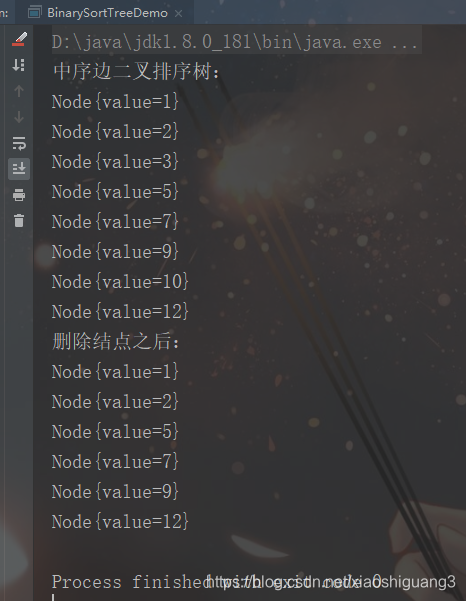二叉排序树(BST (Binary Sort(Search) Tree))
1.基本介绍
对于二叉排序树的任何一个非叶子节点,要求左子节点的值比当前节点的值小,右子节点的值比当前节点的值大。特别说明:如果有相同的值,可以将该节点放在左子节点或右子节点。
比如针对前面的数据 (7, 3, 10, 12, 5, 1, 9) ,对应的二叉排序树为:
2.二叉排序树创建和遍历
3.二叉排序树的删除
二叉排序树的删除情况比较复杂,有下面三种情况需要考虑
删除叶子节点 (比如:2, 5, 9, 12)
删除只有一颗子树的节点 (比如:1)
删除有两颗子树的节点. (比如:7, 3,10 )
第一种情况:删除叶子节点 (比如:2, 5, 9, 12)
思路
(1) 需求先去找到要删除的结点 targetNode
(2) 找到targetNode 的 父结点 parent
(3) 确定 targetNode 是 parent的左子结点 还是右子结点
(4) 根据前面的情况来对应删除
左子结点 parent.left = null
右子结点 parent.right = null;
第二种情况: 删除只有一颗子树的节点 比如 1
思路
(1) 需求先去找到要删除的结点 targetNode
(2) 找到targetNode 的 父结点 parent
(3) 确定targetNode 的子结点是左子结点还是右子结点
(4) targetNode 是 parent 的左子结点还是右子结点
(5) 如果targetNode 有左子结点
5. 1 如果 targetNode 是 parent 的左子结点
parent.left = targetNode.left;
5.2 如果 targetNode 是 parent 的右子结点
parent.right = targetNode.left;
(6) 如果targetNode 有右子结点
6.1 如果 targetNode 是 parent 的左子结点
parent.left = targetNode.right;
6.2 如果 targetNode 是 parent 的右子结点
parent.right = targetNode.right
情况三 : 删除有两颗子树的节点. (比如:7, 3,10 )
思路
(1) 需求先去找到要删除的结点 targetNode
(2) 找到targetNode 的 父结点 parent
(3) 从targetNode 的右子树找到最小的结点
(4) 用一个临时变量,将 最小结点的值保存 temp = 11
(5) 删除该最小结点
(6) targetNode.value = temp
public class BinarySortTreeDemo {
public static void main(String[] args) {
int[] arr = {7, 3, 10, 12, 5, 1, 9, 2};
BinarySortTree binarySortTree = new BinarySortTree();
for (int i = 0; i < arr.length; i++) {
binarySortTree.add(new Node(arr[i]));
}
System.out.println("中序边二叉排序树:"); // 1, 2, 3, 5, 7, 9, 10, 12
binarySortTree.infixOrder();
// binarySortTree.delNode(2);
// binarySortTree.delNode(5);
// binarySortTree.delNode(9);
// binarySortTree.delNode(12);
// binarySortTree.delNode(1);
// binarySortTree.delNode(7);
binarySortTree.delNode(3);
binarySortTree.delNode(10);
System.out.println("删除结点之后:");
binarySortTree.infixOrder();
}
}
//二叉排序树
class BinarySortTree{
Node root;
//添加结点
public void add(Node node){
if (root == null){
//如果根节点为null则直接添加到根节点
this.root = node;
}else {
this.root.add(node);
}
}
//中序遍历
public void infixOrder(){
if(this.root == null){
System.out.println("二叉排序树为空,无法遍历");
}else {
this.root.infixOrder();
}
}
//查找要删除的结点
public Node searche(int value){
if(root == null){
return null;
}else {
return root.search(value);
}
}
//查找要删除的结点的父节点
public Node searchParent(int value){
if(root == null){
return null;
}else {
return root.searchParent(value);
}
}
/**
* 删除已node为根节点的二叉排序树的的最小结点,并返回该最小结点的值
* @param node
* @return
*/
public int delRightTreeMin(Node node){
Node temp = node;
while (temp.left != null){
temp = temp.left;
}
//删除
delNode(temp.value);
return temp.value;
}
//删除结点
public void delNode(int value){
if(root == null){
return;
}else {
//先找到需要删除的结点
Node targetNode = searche(value);
//如果没有找打该节点则直接返回
if(targetNode == null){
return;
}
//如果当前二叉树只有一个节点
if(root.left == null && root.right == null){
//如果root结点就是要删除结点则直接将root置空
if(root.value == value){
root = null;
}
//否则直接返回
return;
}
//找到需要删除的结点的父节点
Node parent = searchParent(value);
//开始删除结点
if(targetNode.left == null && targetNode.right == null){ //要删除的结点是叶子结点
if(parent.left != null && parent.left.value == value){
//如果要删除的结点是父结点的左子树
parent.left = null;
}else if(parent.right != null && parent.right.value == value){
//如果要删除的结点是父结点的右子树
parent.right = null;
}
}else if(targetNode.left != null && targetNode.right != null){ //要删除的结点左子节点和右子节点都不为空
//先找到要删除结点的左子树的最小值并删除该最小值的结点
int minVal = delRightTreeMin(targetNode.right);
//将该最小值赋值给需要删除的结点
targetNode.value = minVal;
}else { //要删除的结点只有一颗子树
//如果要删除的结点有左子树
if(targetNode.left != null){
if(parent != null){
if(parent.left != null && parent.left.value == value){
parent.left = targetNode.left;
}else {
parent.right = targetNode.left;
}
}else {
root = targetNode.left;
}
}else {//如果要删除的结点有左子树
if(parent != null){
if(parent.left != null && parent.left.value == value){
parent.left = targetNode.right;
}else {
parent.right = targetNode.right;
}
}else {
root = targetNode.right;
}
}
}
}
}
}
//创建一个Node结点
class Node{
int value;
Node left;
Node right;
public Node(int value) {
this.value = value;
}
@Override
public String toString() {
return "Node{" +
"value=" + value +
'}';
}
//添加结点
public void add(Node node){
if(node == null){
return;
}
//比较需要添加的结点的值和当前结点的值的关系
if(node.value < this.value){
if(this.left == null){
//如果当前结点的左节点为null,则直接将需要添加的结点添加到该结点的左子树
this.left = node;
}else{
//递归添加向左添加该结点
this.left.add(node);
}
}else {
if(this.right == null){
//如果当前结点的右节点为null,则直接将需要添加的结点添加到该结点的左子树
this.right = node;
}else{
//递归添加向左添加该结点
this.right.add(node);
}
}
}
//中序遍历
public void infixOrder(){
if(this.left != null){
this.left.infixOrder();
}
System.out.println(this);
if(this.right != null){
this.right.infixOrder();
}
}
//根据结点的value值查找结点
public Node search(int value) {
if(this.value == value){
return this;
}else if(this.value > value) {
if(this.left != null){
return this.left.search(value);
}else {
return null;
}
}else {
if(this.right != null){
return this.right.search(value);
}else {
return null;
}
}
}
//根据value查找该元素的父节点
public Node searchParent(int value) {
if((this.left != null && this.left.value == value) || (this.right != null && this.right.value == value)){
return this;
}else {
if(this.value > value && this.left != null){ //向左递归
return this.left.searchParent(value);
}else if(this.value < value && this.right != null){ //向右递归
return this.right.searchParent(value);
}else {
return null;
}
}
}
}
- 结果:



